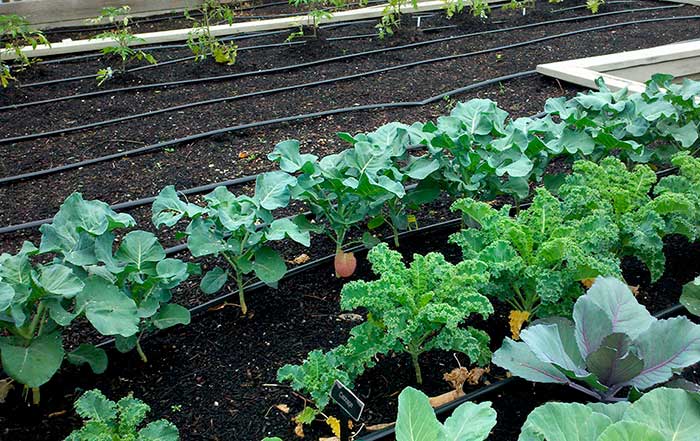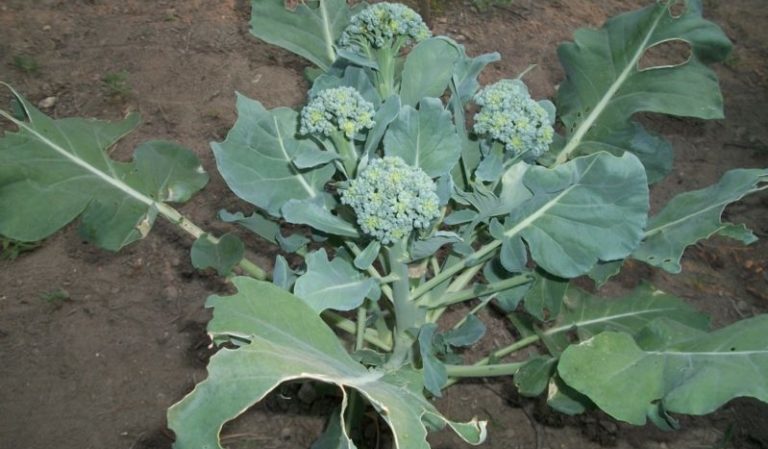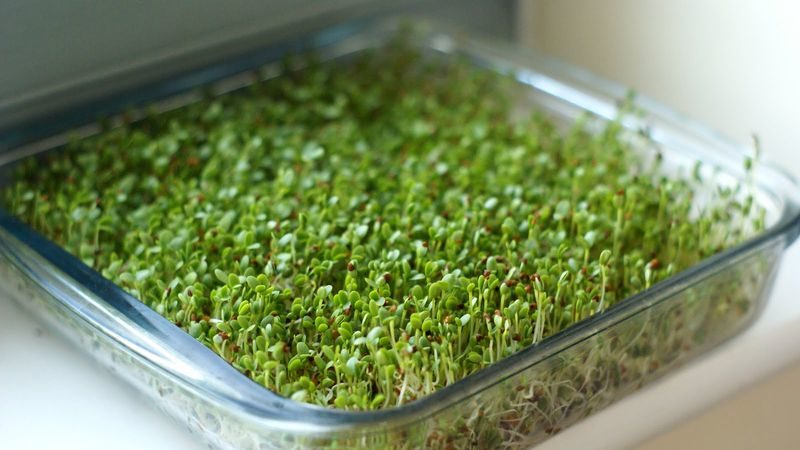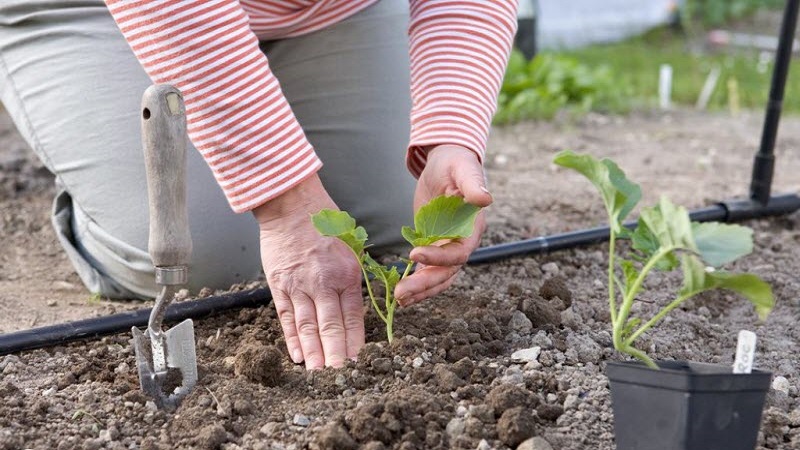Planting and caring for broccoli outdoors
Broccoli, or asparagus cabbage, is an infrequent guest in domestic gardens. Meanwhile, the plant is very tasty and healthy, and unpretentious in care. Broccoli is grown in a seedling and non-seedling way, in open and closed ground, depending on climatic conditions. We will tell you how to plant and grow broccoli in your garden.
The content of the article
When and how to seed broccoli outdoors

Planting material is prepared for awakening before use. For this, the seeds are kept for 10-15 minutes in hot water, then poured in very cold water for 1-2 minutes. After stratification for two days in the refrigerator.
Important! To accelerate germination, stimulants are used, for example, "Heteroauxin".
When to sow seeds
Broccoli matures at low temperatures. Otherwise, it goes into bloom early, which leads to loss of yield or the formation of poor-quality heads of an icteric color.
For the middle lane, the optimal planting time is from mid to late June. Then broccoli will form inflorescences after the August heat has subsided. With early spring plantings, there is a risk of losing plants in the event of recurrent frosts.
Important! Asparagus dies at -4 ° C.
For the southern regions, sowing broccoli is preferable in early spring (in the first - second decade of March) or in early July. Then the plants will not form at high temperatures and will give a generous harvest.
How to plant correctly in the garden

The seedless method saves time and effort for summer residents, so many people try to grow broccoli in this way. The soil for the beds is prepared in the fall, dug deeply and organic fertilizers are applied.
In the spring, the soil is re-loosened and well moistened. The prepared seeds are planted to a depth of 2 cm, sprinkled with earth and mulched to prevent the soil from drying out.
The first shoots appear after 6-7 days. Correctly prepared seeds hatch together, which facilitates further care. When 2-3 true leaves appear, broccoli is thinned out, leaving the most developed and healthy plants at the rate of 4 bushes per 1 m².
Important! If there is a threat of frost, the hatched sprouts are covered with non-woven material or mini-greenhouses are arranged using inverted and cut plastic bottles.
Planting seedlings in open ground
A more familiar way growing cabbage - seedling. With proper care, the gardener gets strong, healthy plants that can survive a transplant without much stress. This method is also good because the plants will more easily adapt to light frosts.
How to grow seedlings

Planting material is prepared in the same way as for sowing. into open ground. The soil is disinfected with a strong solution of potassium permanganate and dried. Then the seeds are slightly moistened and buried by 1.5-2 cm.
The cabbage boxes are covered with glass or foil and placed on the windowsill. For early plantings (March - April) seedlings it is necessary to light up for 3 hours in the morning and 4-5 hours in the evening.
When to sow
For central Russia, the optimal time is late April or early May. For the southern regions - mid-February. In the Urals and Siberia, seedlings begin to be prepared in mid-May.
Permanent boarding rules

In the European part of Russia, grown plants are planted in the ground in early June.By this time, the asparagus has already reached 10-15 cm in height and will get stronger in order to take root well in a permanent place.
Broccoli grows best in shaded areas. She does not tolerate extreme heat and dry soil. It neighbors well with fruit trees, legumes, garlic, corn. It should not be planted next to other types of cabbage.
Good precursors for broccoli are nightshades, cucumbers, pumpkin, and greens. It is impossible to plant cabbage in one place because of the risk of damage by pests wintering in the soil.
The beds prepared in the fall moisten well and plant seedlings in one of the following ways:
- in furrows at a distance of 30-40 cm from each other and with a row spacing of 60 cm;
- in the nests according to the scheme 35 × 35 × 35 cm;
- staggered, keeping between plants 30-40 cm.
Any of these methods provides uniform illumination of the cabbage, the necessary nutritional and moisture rates.
Important! After transplanting, do not water broccoli for several days, otherwise the roots will not be able to strengthen. To prevent the soil from drying out, it is mulched with straw, mown grass or sawdust.
Outdoor broccoli care
Like all crucifers, asparagus is sensitive to feeding, moisture and light levels. Heavy soils are loosened at least 2-3 times a week, ash and organic matter are added. On light soils, there is a risk of drying out the top layer, so they are mulched with hay, straw, sawdust.

How to care after sowing
The main activities during the growing season are weed control, prevention of pests and diseases, fertilization and moisture.
Watering
Broccoli is moisture-loving, but does not tolerate stagnant water. Water it abundantly 2-3 times a week. To prevent soil erosion, use a sprinkler method or use a watering can with small holes. The best time to water is early morning or evening. When water gets on the leaves in the midst of solar activity, the plants get burned.
Top dressing
Fertilizers are applied for the first time 2-3 weeks after planting seedlings in the ground. For this, manure diluted in a 1: 6 ratio or potash-phosphorus fertilizers are suitable in accordance with the manufacturer's recommendations.
The second feeding - during the formation of inflorescences. In this phase of the growing season, broccoli needs nitrogen and phosphorus fertilizers: nitrophosphate or superphosphate at the rate of 2 tbsp. l. 10 liters of water for every 15 plants.
After cutting off the central heads, the asparagus begins to form the side ones. At this time, it is fed with complex mineral additives or organic matter in the form of compost.
Important! For good development of heads, potassium, nitrogen, iron, phosphorus are needed.
Pest prevention
Broccoli beds regularly get rid of weeds - breeding grounds for pests. If the crop rotation is observed, the culture is protected from most insects that infect cabbage plantings. To enhance the effect, celery and dill are planted between the plants. This prevents cruciferous flea beetles, cabbage aphids and white beetles.
A decoction of tomato tops, prepared at the rate of 1 kg of leaves per 3 liters of water, well scares away cabbage caterpillars and whiteflies.
Important! A good neighborhood for broccoli is peppermint. It protects against many cruciferous pests.
Conclusion
Even a beginner can handle open field planting and caring for broccoli. She is the most unpretentious in comparison with relatives. It is not difficult to grow it seedling and seedling methods, subject to the rules of crop rotation. The use of fertilizers increases yields, and properly selected neighbors protect against most pests.